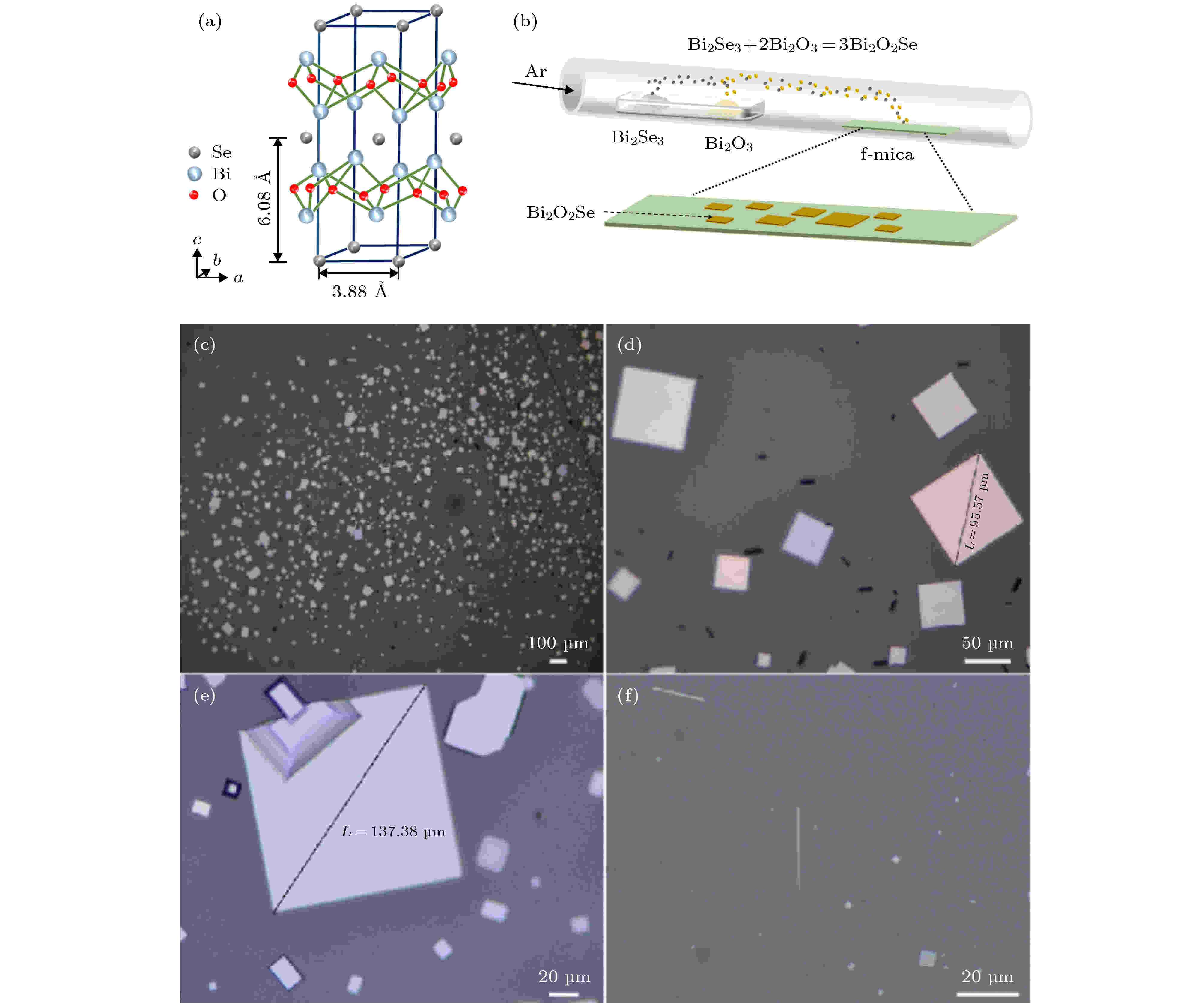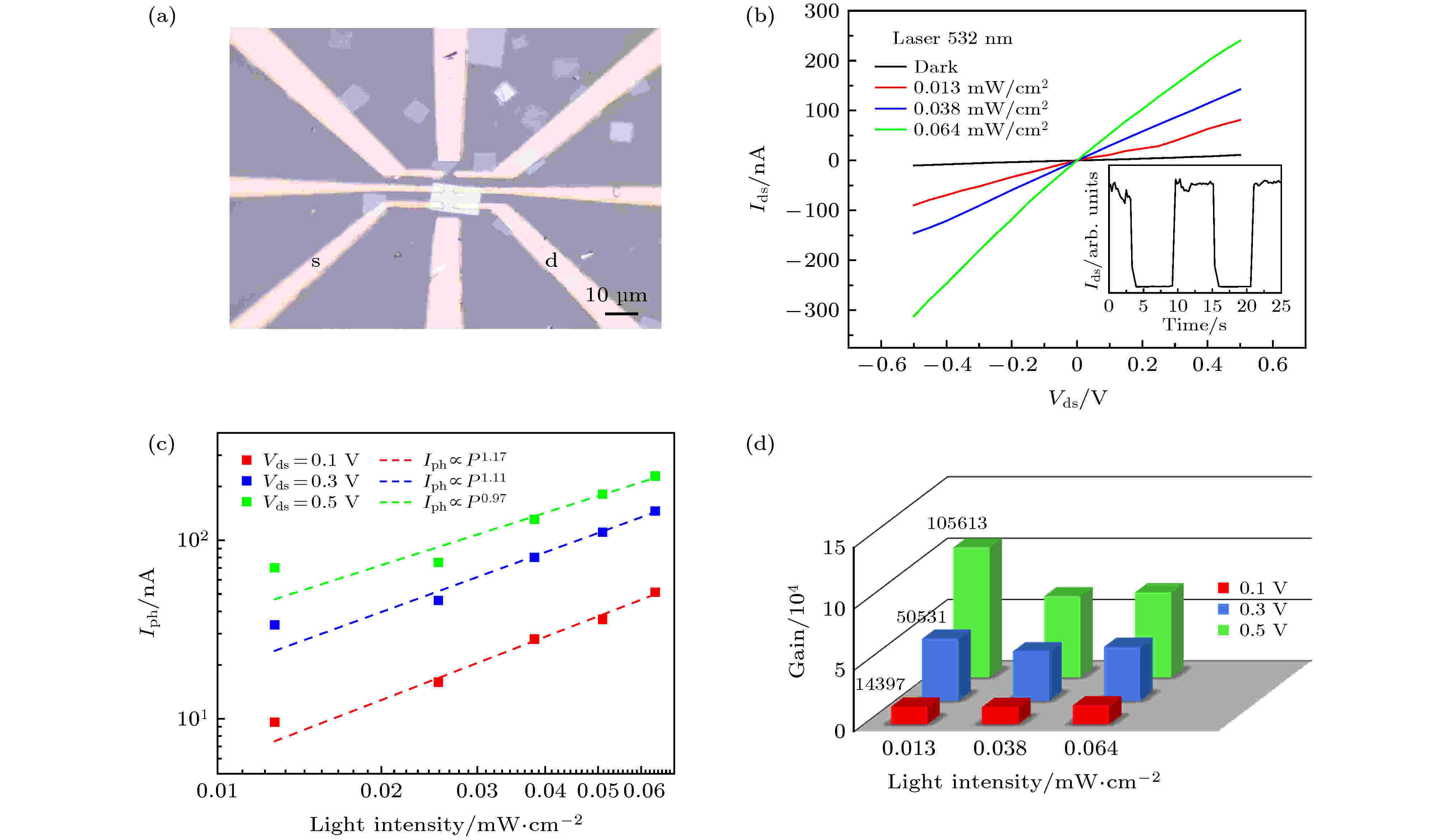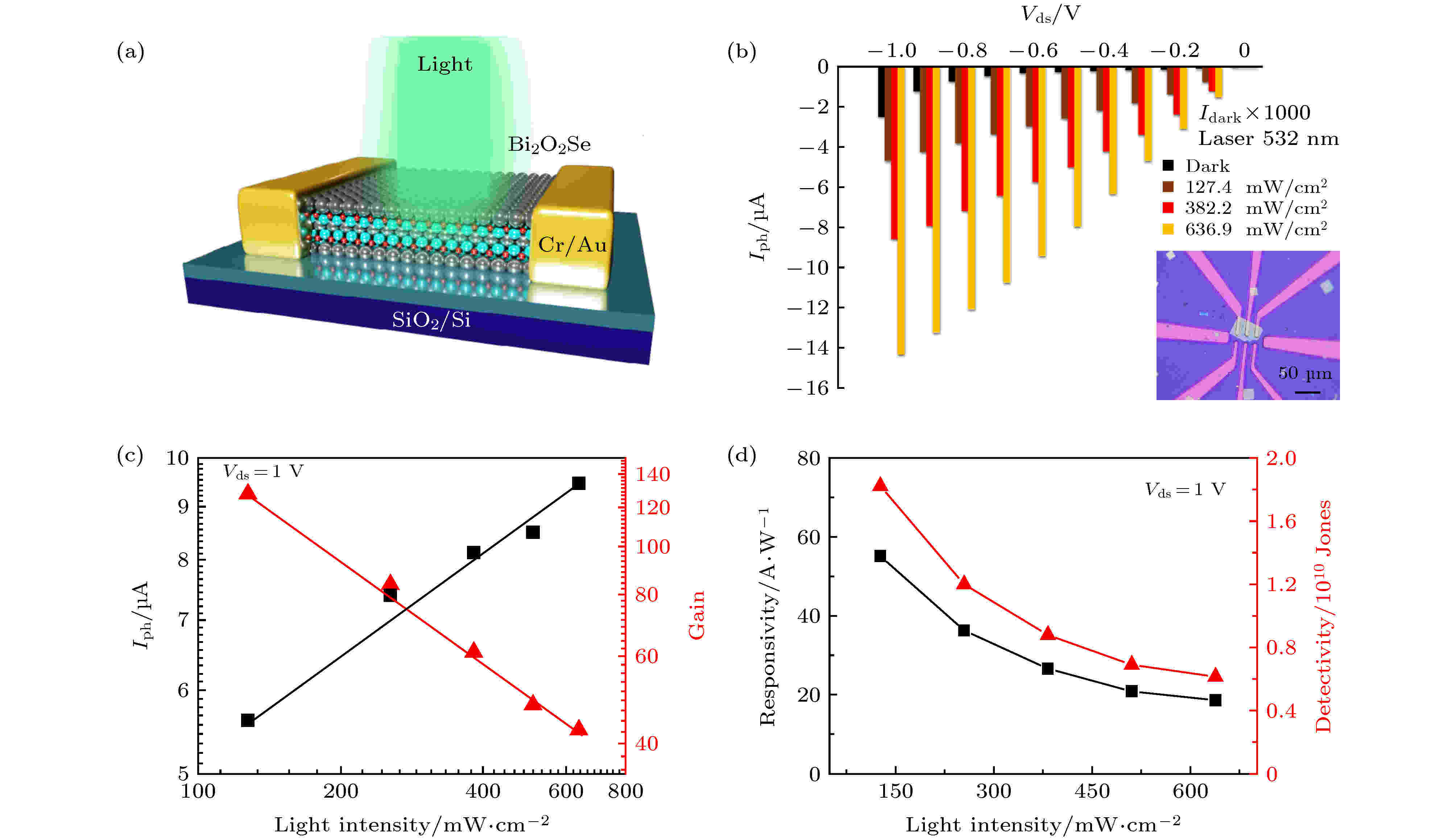全文HTML
--> --> -->

 图 1 (a) 层状Bi2O2Se晶体结构示意图; (b) CVD法合成Bi2O2Se实验装置示意图; (c)—(e) 云母上Bi2O2Se薄膜不同放大倍数的光学照片; (f)云母上Bi2O2Se纳米线光学照片
图 1 (a) 层状Bi2O2Se晶体结构示意图; (b) CVD法合成Bi2O2Se实验装置示意图; (c)—(e) 云母上Bi2O2Se薄膜不同放大倍数的光学照片; (f)云母上Bi2O2Se纳米线光学照片Figure1. (a) Schematic diagram of the layered Bi2O2Se crystal structure; (b) schematic diagram of the CVD experimental setup for synthesis of Bi2O2Se film; (c)–(e) optical images of Bi2O2Se thin films grown on mica at different magnifications; (f) optical image of Bi2O2Se nanowires grown on mica.
本文使用化学气相沉积(chemical vapor deposition, CVD)法在云母上合成了大面积高质量的2D Bi2O2Se薄膜, 并在此基础上制备了光电导探测器. 室温下, 云母上的Bi2O2Se薄膜光电导探测器表现出优异的光电性能, 在没有栅压调控的条件下, 其响应度和比探测率分别高达45800 A/W和2.65 × 1012 Jones, 光增益为105613, 其结果可以和目前报道的最好器件性能相比拟[7,9,12,15].
2.1.Bi2O2Se薄膜的制备
采用一步CVD法在云母上合成了Bi2O2Se薄膜. CVD装置是一个单温区的管式炉(OTF-1200X, 合肥科晶), 石英管外径为60 mm, 长为1.2 m. 实验装置如图1(b)所示, 首先将Bi2Se3(99.99%, Alfa Aesar)和Bi2O3粉末(99.999%, Alfa Aesar)装入石英舟中并置于石英管内, 其中Bi2O3位于管式炉中心高温区域, Bi2Se3位于石英管上游, 和中心相距6 cm, 将新剥离的云母片放置在下游, 距离Bi2O3 18—21 cm之间. 然后将石英管密封抽真空, 并用高纯度Ar气体冲洗, 以提供无氧环境, 实验过程中一直通Ar作为载气, 其恒定流速设置为50—100 sccm (1 sccm =1 mL/min). 具体生长过程为: 首先将管式炉升温至目标温度, 升温速率设置为10 ℃/min, 到达目标温度后保温~40 min. 生长结束后炉子自然冷却至室温, 开腔取样.2
2.2.聚苯乙烯(polystyrene, PS)辅助的转移方法
采用PS辅助的非腐蚀性转移方法将Bi2O2Se薄膜转移到Si/SiO2衬底上. 首先将Si/SiO2基片依次在乙醇、异丙醇和去离子水中超声清洗 10 min并烘干备用. 然后通过匀胶机(SPIN-1200 D)将配置好的PS溶液在2000 r/min下旋涂在样品表面, 时间约为45 s, 并在自然环境下干燥10 min. 然后在去离子水(DI)的帮助下将PS 薄膜和Bi2O2Se一起从云母上剥离开, 同时将带有Bi2O2Se的PS 薄膜转移至 Si/SiO2衬底上, 分别在80 ℃下干燥10 min, 并在130 ℃的热板上加热30 min, 以改善Bi2O2Se与Si/SiO2衬底的接触. 最后将样品浸入到甲苯溶液中浸泡10 min以去除PS薄膜, 再浸入丙酮中去除有机残留物. 这样, 可以成功实现Bi2O2Se薄膜从云母基片到Si/SiO2基片上的转移.2
2.3.器件的制备与表征
通过光学显微镜(Olymbus BX53 M)、原子力显微镜(Bruker Multimode 8)和显微共焦激光拉曼光谱仪(Reinshaw invia-Reflex)对Bi2O2Se进行形貌、结构表征. 然后通过紫外光刻技术和热蒸发镀膜设备在Bi2O2Se薄膜上制备金属电极, 具体过程如下: 1)通过紫外光刻技术制备电极图案. 首先将样品用去离子水进行清洗, 并在氮气气氛下烘干, 冷却后在样品上旋涂光刻胶(AZ6130), 转速和时间分别为4000 r/min和60 s, 然后放在烘箱中煎膜1 min, 将样品放到紫外光刻机中进行曝光, 约9 s. 最后将曝光后的样品置于显影液中显影1 min并用去离子水清洗, 这时掩膜版上的图形被成功转移到光刻胶薄膜上. 2)利用热蒸发镀膜设备(北京泰科诺科技有限公司, 高真空电阻蒸发镀膜机XHD-400)蒸镀电极, 采用Cr/Au(5 nm/50 nm)作为金属电极. 电极制备好后, 再用丙酮和无水乙醇洗去剩余的光刻胶, 最终完成器件制备. 本实验的光电测试采用探针台(Semishare)和Keithley 2634B源表完成, 光源采用功率可调的532 nm激光.管式炉的温度对Bi2O2Se生长非常重要, 控制管式炉温度分别为640, 660, 680 ℃, 在三种温度下生长的样品光学照片如图2(a)—(c)所示. 从3幅图可以清楚地看到在这3个温度下都可以获得矩形的Bi2O2Se薄膜, 但是它们的分布密度和大小十分不同. 在温度较低和较高的情况下, 薄膜成核点数量较多, 但是尺寸普遍较小, 而在660 ℃下薄膜成核点数量很少, 但是每个单畴的Bi2O2Se的尺寸较大. 图2(d)为Bi2O2Se尺寸分布图, 可以更直观地看到纳米片尺寸随温度的变化. 随着温度的升高, Bi2O2Se薄膜尺寸呈现出先增加后减小的变化趋势. 当衬底温度相对较低时, 由于临界形核自由能低, 前驱体容易形核, 形核密度较大, 但是受分子扩散速率较低的影响, 薄膜尺寸较小. 当进一步升高温度时, 临界核半径和成核自由能势垒均增大, 导致成核困难, 成核密度相应降低, 同时分子热运动动能增加, 促进了前驱体分子的表面扩散和互相反应, 因此Bi2O2Se单畴面积较大. 然而, 当继续升高温度超过某一临界值时, 过高的温度会造成分子热动能过大, 分子运动比较活跃, 造成前驱体分子容易解吸附, 最终导致Bi2O2Se尺寸又变小.
 图 2 生长温度对Bi2O2Se薄膜形貌及尺寸分布的影响 (a)—(c) 不同生长温度下云母上Bi2O2Se薄膜的光学照片; (d) 不同生长温度下Bi2O2Se的尺寸分布图, 不同颜色代表不同尺寸范围的Bi2O2Se
图 2 生长温度对Bi2O2Se薄膜形貌及尺寸分布的影响 (a)—(c) 不同生长温度下云母上Bi2O2Se薄膜的光学照片; (d) 不同生长温度下Bi2O2Se的尺寸分布图, 不同颜色代表不同尺寸范围的Bi2O2SeFigure2. Effect of growth temperature on the morphology and the size distribution of Bi2O2Se films: (a)–(c) Optical images of Bi2O2Se thin films grown at 640, 660, 680 ℃, respectively; (d) size distribution of Bi2O2Se films prepared at different growth temperatures. Different color denotes different size range.
Bi2O2Se薄膜的原子力显微镜图像如图3(a)所示, 可以看到其厚度约为20 nm, 根据单层的理论厚度0.61 nm[9], 20 nm约等于32层的厚度. 图3(b)是在室温532 nm激光激发下Bi2O2Se的拉曼光谱, 其光学声子振动模式A1g特征峰位于157.7 cm–1处, A1g模式是由于Bi原子沿晶体z轴的面外振动引起的, 原子振动模式如图3(b)插图所示[21,22].
 图 3 (a) Bi2O2Se薄膜的原子力显微镜照片; (b) Bi2O2Se薄膜的拉曼光谱, 插图代表A1g振动模式中各原子间的相对运动
图 3 (a) Bi2O2Se薄膜的原子力显微镜照片; (b) Bi2O2Se薄膜的拉曼光谱, 插图代表A1g振动模式中各原子间的相对运动Figure3. (a) Atomic force microscope image of a typical Bi2O2Se thin film with a thickness of 20 nm; (b) Raman spectrum of Bi2O2Se thin film. The inset shows the relative motion of atoms in the A1g mode.
在云母片上原位制备了Bi2O2Se光电导探测器, 图4(a)为器件的光学照片. 器件的电流-电压关系曲线如图4(b)所示, 其线性行为表明金属电极和Bi2O2Se之间形成了良好的欧姆接触. 器件在0.5 V偏压下暗电流只有10 nA, 功耗只有5 nW. 当用波长为532 nm的激光辐照, 光功率密度为0.064 mW/cm2时, 光电流达到0.24 μA, 此时光暗电流比为24. 图4(b)中插图为器件时间响应的光波图, 可以看出器件具有很好的光开关特性, 器件的上升时间和下降时间差不多, 约为0.2 s. 图4(c)为光电流(Iph)随光功率密度(P)变化的关系曲线, 可以通过

 图 4 (a)云母片上Bi2O2Se光电导器件的光学图像; (b)不同光功率密度下Bi2O2Se 器件的Ids-Vds曲线, 插图为器件时间响应的方波图; (c)不同偏置电压条件下, 光电流(Iph)与光功率密度的关系; (d)不同偏置电压条件下, 光增益与光功率密度的关系
图 4 (a)云母片上Bi2O2Se光电导器件的光学图像; (b)不同光功率密度下Bi2O2Se 器件的Ids-Vds曲线, 插图为器件时间响应的方波图; (c)不同偏置电压条件下, 光电流(Iph)与光功率密度的关系; (d)不同偏置电压条件下, 光增益与光功率密度的关系Figure4. (a) Optical image of a Bi2O2Se photoconductive detector on mica; (b) Ids-Vds curves of Bi2O2Se device under illumination by laser with different optical powers; (c) light power dependence of photocurrent (Iph) under different bias; (d) relationship between light gain and light power under different bias.
光增益(G)是表征光电器件性能的另一个重要参数, 它定义为每个被吸收的入射光子可收集到的电子数. 它可以通过(3)式计算
| Materials | Fabrication method | Responsivity/A·W–1 | Detectivity/Jones | Rise time/ms | Reference |
| MoS2 | ME | 434 | 1011 | 120 | [23] |
| ReS2 | CVD | 1208 | 1010 | — | [24] |
| SnS2 | CVD | 167 | — | 100 | [25] |
| SnSe2 | CVD | 1000 | 1010 | 14.5 | [26] |
| In2Se3 | ME | 59 | 1011 | 0.18 | [27] |
| Graphene | CVD | 0.73 | 1013 | 0.32 | [28] |
| BP | ME | 4.8 × 10–3 | — | — | [29] |
| Bi2O2Se | CVD | 45800 | 1012 | 200 | This work |
表1Bi2O2Se与其他2D半导体光电晶体管性能比较(ME, 机械剥离)
Table1.Comparison of the performance of Bi2O2Se with other 2D semiconductor phototransistors (ME represents mechanical exfoliation method).
我们还进一步研究了云母基片上Bi2O2Se纳米线的光电行为. 图5(a)为器件在暗态和不同光功率照明下的Ids-Vds特性, 其插图为Bi2O2Se纳米线器件的光学照片. 可看出Ids-Vds曲线呈现非常好的线性关系, 表明金属电极和材料之间为欧姆接触, 在光功率密度为636.9 mW/cm2, 偏置电压为1 V时, 光电流达到了65.3 nA, 光暗比达到102. 在光功率密度为127.4 mW/cm2和偏压为1 V时, R和D*最大值分别为0.071 A/W和1.63 × 108 Jones (图5(b)). 与前面矩形的Bi2O2Se器件相比, Bi2O2Se纳米线光电探测器的R和D*要小很多, 这是因为该器件沟道长度为50 μm, 约为图4中器件沟道长度(5 μm)的10倍, 在相同偏压下, 电场强度将减弱为原来的1/10, 不利于光生载流子的收集. 另一个更重要的原因是由于我们实验中所用光源光功率密度较大(光功率密度比前面大了2000倍, 没有经过滤光片衰减), 这时光生载流子寿命较短, 导致光增益下降, 灵敏度和比探测率降低.
 图 5 (a) 不同光功率下Bi2O2Se纳米线光电探测器的Ids-Vds曲线, 插图为器件光学图像; (b) 在不同入射光功率密度下器件的响应度和比探测率
图 5 (a) 不同光功率下Bi2O2Se纳米线光电探测器的Ids-Vds曲线, 插图为器件光学图像; (b) 在不同入射光功率密度下器件的响应度和比探测率Figure5. (a) Ids-Vds curves of Bi2O2Se nanowire photodetector on mica under different light powers. Inset is an optical image of the device. (b) Responsivity and specific detectivity of the device at different light powers.
为了和半导体工艺相兼容, 将云母基片上生长的矩形Bi2O2Se薄膜转移到Si/SiO2衬底上, 评估转移后Bi2O2Se的光电性能. 图6(a)为Si/SiO2衬底上Bi2O2Se光电器件结构示意图, 在暗态和不同光功率的532 nm激光辐照下, 器件的电流-电压数据如图6(b)所示, 在Vds = –1 V时, 暗电流低至2.4 nA, 并且在636.9 mW/cm2光功率密度下光暗比达到103. 当入射光功率为636.9 mW/cm2, 偏置电压为–1 V时, 其光电流可以达到14.4 μA. 从图6(c)可以看出光电流随光功率的增加而增加, 而光增益却与之相反, 在Vds = 1 V, 光功率为127.4 mW/cm2时, G值达到127. 图6(d)为器件在不同光功率密度下获得的光响应度和比探测率, 可以看到响应度和比探测率均随光功率密度的增大而减小. 在入射光功率密度为127.4 mW/cm2, 偏置电压为1 V时, 响应度达到55.1 A/W, 比探测率高达1.82 × 1010 Jones, 这里响应度仍远远高于商用硅光电器件的响应度0.78 A/W[30].
 图 6 (a) Si/SiO2衬底上的Bi2O2Se器件示意图; (b) 不同光功率下Bi2O2Se探测器的Ids-Vds行为, 插图为器件的光学图像; (c) Iph、光增益与光源功率密度的关系; (d) Bi2O2Se探测器的响应度和比探测率对光源功率密度的依赖关系
图 6 (a) Si/SiO2衬底上的Bi2O2Se器件示意图; (b) 不同光功率下Bi2O2Se探测器的Ids-Vds行为, 插图为器件的光学图像; (c) Iph、光增益与光源功率密度的关系; (d) Bi2O2Se探测器的响应度和比探测率对光源功率密度的依赖关系Figure6. (a) Schematic diagram of the Bi2O2Se photodetector on a Si/SiO2 substrate; (b) Ids-Vds of Bi2O2Se detector under different light powers, the inset is an optical image of the device; (c) under different biases, the relationship between photocurrent, optical gain and light intensity; (d) light power dependence of responsivity and specific detectivity of the Bi2O2Se detector.
